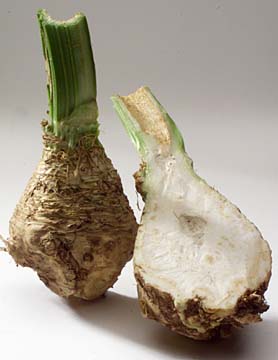

Key Ingredient

There's probably no vegetable quite as daunting as the celery root, or celeriac. Gnarly, knobby and just plain ugly are words that come to mind when describing this turnip-like tuber. But you can't judge this book by its cover -- don't be too quick to dismiss this unique bulbous root. CELERY ROOT
The basics: Celeriac is a member of the celery family cultivated specifically for its root. The outside jacket consists of a rather grimy, brown, rough exterior, which contrasts directly with its light, cream-colored interior. Celery root has a distinct celery flavor with the added bite of parsley undertones. The green leaves of the plant are inedible and are usually trimmed off before being sold. Vitamin B, calcium and iron are contained in the flesh.
Selecting: Although the root can grow to the size of a small cantaloupe, look for a small to medium sized product. The larger roots tend to have a spongy, hollow texture. The root should be firm to the touch with no bruises or soft spots and generally heavy for its size.
Storing: Store in a plastic bag in the refrigerator for up to one week.
Use: Celery root can be eaten raw or cooked, although cooked is preferred. Scrub the root well with a stiff brush under running water. Trim any bits of roots and peel the outer skin. The inner flesh will start to brown when exposed to air, so immediately place the root in a bowl of water with vinegar or lemon juice and soak for a few minutes to prevent discoloration. If eating raw, grate or shred the root and add to salads. Or, enjoy it the classic French way, with a remoulade (sauce of mayonnaise, Dijon mustard, capers and herbs). Celery root is more commonly enjoyed as a purée or in soups. Also, add parboiled celery root to potatoes and mash together for a zesty side dish.
Where to buy: Celeriac can be found in supermarkets from late autumn through spring and costs $3 to $5 a pound.
Food Stuffs: Morsels
Contact Eleanor Nakama-Mitsunaga
online at features@starbulletin.com
Asterisk (*) after nutritional analyses
indicates calculations by
Joannie Dobbs of Exploring New Concepts,
a nutritional consulting firm.